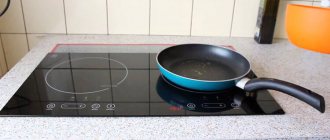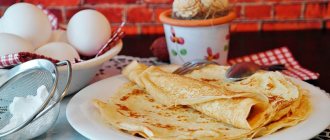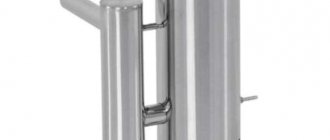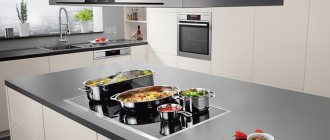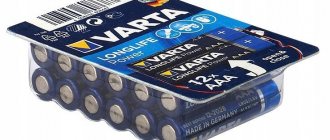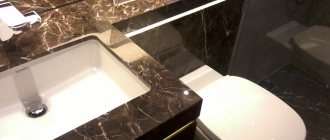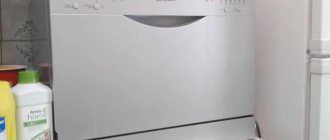When purchasing a new home or carrying out major renovations to an existing one, everyone wants to do everything in a design that is original and at the same time practical. It is impossible to achieve both one and the other without the use of nanotechnology. After all, only fashionable new equipment has both a magnificent appearance and extensive functionality. One of these modern attributes in kitchen furniture is the glass-ceramic stove. Let's try to determine the pros and cons and find out: is this a really stylish, practical thing or just a whim of the rich? Or maybe the costs of modernity? Or is it still a necessity that alleviates a woman’s lot?
Advantages
Among the advantages are noted:
- Supports instant heating function.
- Resistance to high temperatures.
- A high-quality stove with a glass-ceramic surface is characterized by low horizontal thermal conductivity and relatively high vertical thermal conductivity.
- High strength.
- Low power consumption compared to stoves that run on gas. Experienced users consider a glass-ceramic stove as a saving tool. Today, gas tariffs are rising every day, so electricity consumption will be cheaper.
- The glass ceramic coating cools quickly. This allows for a dynamic response to changes in switch position. Until recently, this was characteristic only of gas surfaces.
- Selecting a heating zone. You can regulate the heated area yourself. This allows you to use dishes with different diameters.
- Possibility of using dishes of specific shapes. Depending on the model of the glass-ceramic stove, the shape of the burners can be not only round, designed for dishes with a round bottom, but also other shapes that make it possible to use a caterpillar, as well as vessels of various configurations.
- Advanced functionality. If previously the main purpose of the stove was cooking, now there is a timer function, automatic shutdown when boiling, auto-cooking mode and others. All this makes the housewife’s work easier and does not require her full participation.
- Child protection. Another feature of modern models of glass-ceramic stoves that allows you to prevent children from accessing the unit’s navigation and avoid various kinds of troubles.
Pros and cons of tempered glass
The principle of manufacturing this material is simple, but it is thanks to it that glass becomes incredibly durable. The maximum possible heating of the material is carried out, after which it is subjected to extreme cooling. This is precisely why it is almost impossible to break or damage it with any object other than metal. And it is precisely because of this that it has become so popular and is used not only for hobs, but also in the installation of double-glazed windows and partitions.
Tempered glass hob
There is no need to remove the burners to clean the surface. It is enough to walk over the surface with a dry towel (wet cleaning will be a little more problematic, since stains may remain). It will be difficult to get burns, since the glass will not heat up during the cooking process. The cost of such products is more than affordable, and in terms of quality they are in no way inferior to their ceramic counterparts.
| Advantages | Flaws |
| The material is incredibly durable and resistant to mechanical damage | This surface cannot be cut or drilled. |
| Excellent flexibility | The edges may develop chips over time. |
| Thermal resistance | Difficulty cleaning (stains) |
Flaws
The glass-ceramic stove has pros and cons. The latter, according to owner reviews, include:
- The need to purchase dishes from certain materials. Depending on the type of burners (standard, induction, Hi-light, halogen) you can use one or another cookware on the stove.
- Specifics of care. A glass ceramic hob requires special care. Cleaning the surface must be done with a special tool using appropriate household chemicals, which usually cost a lot.
- Strong static loads are contraindicated.
- Precision strikes are contraindicated.
- Low sides. This means that if, for example, soup or milk escaped during the cooking process, then you will have to catch it on the floor. Consequently, not only the working hob, but also the floor will be contaminated.
- "Diabetes". The glass-ceramic stove is very afraid of sugar, both in its pure form and in liquids (jam, jam, syrup, etc.). It is almost impossible to clean burnt residue.
- Sudden temperature changes are contraindicated. When the stove is in operating mode, that is, turned on, you should avoid getting cold liquid on it. If this happens once, there is no need to worry, but if this happens systematically, it will soon cause the slab to fail.
Analyzing the above, we can conclude that the disadvantages of glass-ceramic stoves are the complexity of operation and the need for maintenance. In this aspect, traditional electric stoves benefit, of course. But such a drawback is nothing compared to the performance characteristics.
What is a glass-ceramic combination hob and is it worth buying?
Combined stoves have a hob and an oven of different types. Most often, the hob is gas, and the oven is electric. The hob can be made from various materials. The material for an electric stove can be made of stainless steel or glass ceramics. Models based on combined materials are widely represented. Depending on the type of hob, such a stove may have a gas or electric oven.
When choosing different types of combined kitchen stoves, it is necessary to take into account not only its appearance, but also the types of burners and functionality. Some types of combined stoves have a special compartment for a gas cylinder. Such models are recommended if there is no centralized gas supply.
Separately, combination hobs, which combine gas burners and electric burners, should be cancelled. Such models are the optimal solution in case of interruptions in gas or electricity, however, they are more difficult to repair and are more expensive than simple models.
Which utensils can be used and which cannot?
A glass-ceramic stove requires a special selection of cookware. The pros and cons of this criterion, which must be observed according to the operating rules, converge. So, purchasing new cookware is primarily costly from a financial point of view. But if you buy the right utensils, you will be guaranteed a quick cooking process and a long service life of the stove.
Glass-ceramic electric stove
The heating elements of such a stove are covered with a glass-ceramic panel. Such panels are actually not exactly glass, although they look similar. They are made by melting using a special technology. As a result, the glass becomes impact-resistant, resistant to temperature changes and at the same time highly permeable to heat.
Glass-ceramic stoves differ from each other in their set of functions, and most importantly, in the heating elements located under the glass.
For example, there is:
Halogen burners. They heat up very quickly, glow red during operation, and are quite powerful. But at the same time, they consume a lot of energy and have a short (comparatively) service life.
Rapid burners. They take a little longer to heat up (12 seconds instead of 3). But they are more economical.
Article on the topic
Electric versus gas: how to make friends with a new stove
pros
- The burners heat up and cool down faster than regular electric stove burners.
- The degree of heating is well regulated.
- Cleaning the stove is easier; you don’t need to clean out burnt food from the cracks.
- Manufacturers usually make burners of different sizes, which allows them to be used more efficiently.
- A set of various additional functions, for example, changing the heating zone, turning on the timer, indicators for heating the burners, and so on.
- Modern look
Minuses
- Use cookware with a smooth, flat bottom, and the bottom should be no more and no less than the burner underneath it. This often leads to the purchase of new, suitable cookware.
- Relatively high price.
- Point impact can destroy the glass-ceramic panel, so do not drop knives, forks, etc. onto the stove.
- He is afraid of sudden changes in temperature; he cannot put something cold on a hot burner, nor should he spill something cold on a hot plate.
- You should not use aluminum or copper cookware, even if it has a flat bottom; such cookware will leave stains on the burner that cannot be washed off.
- Requires special cleaning agents and scrapers.
Life without a stove. What equipment can replace the hob and oven Read more
Features of choosing dishes
- Smooth, undeformed bottom.
- The diameter of the bottom of the pot or frying pan must match the diameter of the burner.
- Aluminum and copper utensils cannot be used. Some manufacturers of hob surfaces overlook this issue, but in practice it has already been proven that the use of pots, pans and kettles made of these materials can lead to the appearance of pearlescent stains on glass ceramics, which in most cases cannot be washed off.
- If the hob is equipped with induction-type burners, then the cookware should be steel, enameled or cast iron. The use of utensils made from other materials is strictly prohibited. In addition, the bottom of the cookware for induction cookers must have ferromagnetic properties. Checking their presence is very simple - just place a magnet at the bottom of the container. If it is attracted, it means that a ferromagnetic element is present and such cookware is suitable for use on “smart” hobs. The same cannot be said about containers made of glass, porcelain, copper, brass, and ceramics.
Glass-ceramic hob: pros and cons in the original material itself
Of course, having reached the concept of using the former telescopic source for kitchen appliances, the material has undergone significant changes. But the essence remains the same: the basis of any glass-ceramics is glass-ceramics and astro-ceramics - in simple terms, glass-crystalline structures that have a whole range of unique properties.
The advantages and disadvantages of these types of materials are laid down at the stage of birth of the future panel, or rather, its surface:
- In a glass melting furnace, “green” glass is cast, which does not yet differ in any way from ordinary glass. Among the manufacturing suppliers are Schott Glass and Eurokera (France).
- Next comes the personalization process. The glass is cut to a given shape (it will be different for each model). Here the edges are processed and decor is applied. So, here is the first advantage - originality and unique design from each manufacturer (Hansa paints the signs of the Zodiac, and Zigmund & Schtain even presents frescoes). In fact, the decor penetrates the glass at the diffusion level, which means it is impossible to remove it later. Here is the second plus - the coating cannot be removed (and maybe a minus if we are talking about manufacturer errors, but this does not concern customers).
- And here is the main point - ceramicization. This is where secret ingredients from each manufacturer (special crystals) are added. They give the glass low expansion when heated.
All these physical and technological aspects are given for a reason - they are reflected in the “talents” and skills of the panel.
Glass-ceramic hob: advantages in general terms
Equipment manufactured in accordance with all the rules will be capable of the following feats:
- Such a panel can withstand heating up to 600°C, and it can do this in a matter of seconds.
- She is not afraid of sudden changes in temperature (you can place ice on a heated burner and not see any harm in it).
- The special heat conductivity also deserves attention. Glass ceramics conduct it perfectly across the surface and very poorly along the surface. This is very good for those preparing food - in case of accidental contact with the stove it will be impossible to get burned.
- Despite its apparent fragility, such a panel is capable of withstanding a fairly noticeable static load, that is, it has a good margin of safety.
- There is a controversial issue about impact loads - even though in laboratory conditions they drop pots from a height of half a meter, such a unit must fall perfectly parallel in order to get the desired result. Real life is not a laboratory; here no one is safe from the fact that the dishes will fall on their edges (and, in any case, they will tilt in one direction or another).
Cons of a glass-ceramic hob
It is better not to hang kitchen utensils such as frying pans, knives, etc. above such a panel. If they fall on glass ceramics, hitting, of course, an edge, the result can be very sad.
The disadvantages of a glass-ceramic hob are that it does not like sugar, plastic and aluminum. It cannot be cleaned with steel wool, a brush or a knife. It is also not recommended to use abrasives.
Special means for washing such surfaces are also expensive. Of course, the consumption is small, but you will have to buy it in any case - this way the glass ceramics can be maintained in well-groomed condition. Plus, the products will leave a special film that will help protect the panel if a liquid with a high sugar content accidentally spills there.
Yes, yes, sugar is dangerous for glass ceramics even if it does not fall on it in a free-flowing state. If it is not wiped off immediately, it will leave unpleasant whitish marks. Of course, it will be possible to use the equipment in this case, but the appearance will not return to its previous ideal state.
How to care: features of maintenance of ceramic slabs. Basic Rules
- Use scrapers to clean glass ceramic hobs. Yes, only scrapers. It is strictly forbidden to clean the surface with a knife, a brush, a sponge with a metal surface, or abrasives. The scraper effectively combats various types of contaminants using removable blades. In most cases, such a device comes complete with a hob. But if you don’t find a scraper, don’t worry, purchasing it separately won’t be difficult.
- Use creamy substances to clean glass-ceramic kitchen hobs. Cream or paste eliminates the possibility of scratching glass ceramics. In addition, when such a substance is applied, a so-called protective layer is formed, which prevents scratches to some extent.
What is possible and what is not? Other nuances when caring for glass-ceramic surfaces
It is extremely undesirable to subject a glass-ceramic stove to strong statistical loads. In addition, you should avoid pinpoint impacts in every possible and impossible way, and also avoid scratching the surface. And remember, the hob must always be clean, since permanent contamination is contraindicated for these stoves.
As already noted, the glass-ceramic stove has its pros and cons, but despite this, it is a priority among modern consumers. The positive characteristics are defined more from a technical point of view, while the disadvantages are due to operational features and require the investment of certain funds.
Operating principle of a glass-ceramic hob, main features.
Save the article for yourself or share it on your favorite social networks:
In one of the articles I already talked about how to choose a kitchen stove:
Choosing a stove
This article will be useful for those who have chosen glass ceramics. Glass-ceramic stoves, which can be bought today at any home appliance store at, so far, not too low a price, are a type of electric stoves, the creation of which uses a special glass-ceramic coating. Unlike conventional electric stoves, glass-ceramic devices have a mirror-like smooth surface, and the burners have a purely visual designation. These burners heat up instantly. A red-hot spiral seamlessly transfers heat through the glass to the dishes, which, by the way, must be special. domisad.org
Material
As we have already said, despite being economical, the cost of glass-ceramic stoves is still quite high. Moreover, the high cost is due to the use of a special material called ceran. The hob is made from this material. Ceran is highly durable. And even if you drop a pot of borscht on the hob, the surface will not break. But ceran is unlikely to withstand a dozen such falls, so it is better to handle it as carefully as possible.
Principle of operation
For buyers, the operation of a glass-ceramic stove may seem like real magic. But in fact, in its operation it is similar to cast iron burner models, where the heating element is a transmission link. The heating element is characterized by instant heating and cooling, as well as enviable thermal conductivity. It is noteworthy that heat is conducted exclusively in a given direction. That is, when turned on, you can easily touch it in any other place, without fear of getting burned. As for the heated surface, it cools completely in a minute or two.
Main features of glass-ceramic plates
1. A glass-ceramic stove conducts heat vertically much better than horizontally. Therefore, it is mainly the pan that heats up, and not the surrounding area. This allows you to achieve efficiency by increasing efficiency.
2. The rapid cooling of glass ceramics causes its low inertia. That is, very little time passes after turning the knob and before the temperature of the burner surface actually decreases. A similar effect, although to a lesser extent, can only be achieved in gas ones.
3. Variable heating zone provided by a perfectly flat surface of the hob. The same burner can be used to cook food in containers of different diameters, which makes energy consumption more reasonable and economical.
4. Changing the shape of the burner. You can easily cook food in oval casserole dishes, roasting pans or pans made of heat-resistant glass. There is no need to lift the pan to move it from place to place. You can just move it.
5. The glass ceramic hob has a matte surface. This adds a more neat and noble look to the overall interior of your kitchen.
6. High-quality stoves are equipped with automatic boiling, which reduces the need for the housewife to be present in the kitchen. Having initially set a low power and turned on the automatic, it will start cooking at maximum power until it is completely warmed up, after which the power that you set will be turned on. This function can be turned on automatically, or can be programmed by the user himself, which is convenient when frequently cooking one dish in a given quantity.
And one more useful information about kitchen stoves:
Why can't you place a stove next to a refrigerator?
